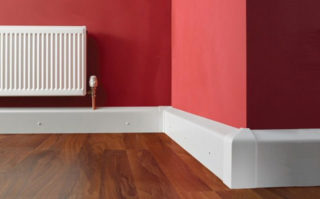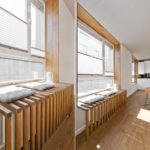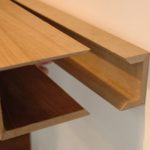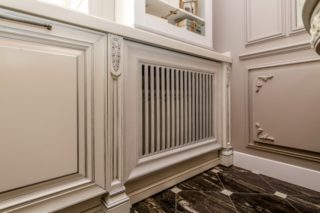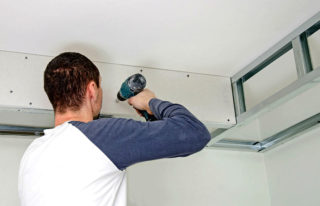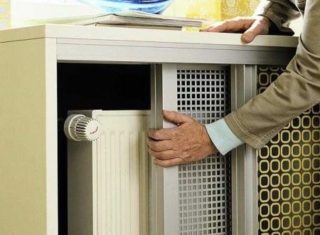The modern design of the living quarters does not involve flaunting heating, gas and water pipes. Engineering communications (with the exception of the Loft and Modern style) do not fit well into the interior of the rooms, violating the integrity and reasonableness of the design. A duct pipe is a great way to hide risers, piping and radiators. There is a wide selection of finishing materials and many technologies for their installation. You can make and install a decorative pipe box for your own hands, saving a good amount on the services of hired craftsmen.
Variants of boxes from manufacturers
When choosing a method for decorating communications in an apartment or house, there is a reason to pay attention to ready-made designs of factory production. The products presented in the distribution network are distinguished by excellent design, precision manufacturing and safety. Another undoubted advantage of store products, which are made in a folding design, is the ability to remove them from the mounts in case of emergency.
A box for a heating radiator can be made of such material:
- Plastic. The production uses polymers that are resistant to heat and safe in terms of ecology. Plastic screens are lightweight, flexible and in various shapes. Channels and plates are available in different colors, including those with applied patterns and ornaments. If you wish, you can make a drawing yourself using paints or an adhesive film. Do not forget about the affordable cost of polymer skirting boards for heating pipes.
- Metal. This material is characterized by high strength, reliability and durability. The metal box for the battery heats up from it and transfers heat to the room. In the manufacture of brass, copper, but most often stainless steel. If an external finish is used, the coating is applied with powder paint, which is then baked at high temperature. If desired, the cladding can be changed using spray cans of paint.
- MDF. Lightweight and beautiful panels have low thermal conductivity, which is compensated by perforation and arrangement of slots for the release of warm air. For the decoration of the housing, the material that is best combined with the interior is selected. You can also use paint or wallpaper. The disadvantage is that over time, MDF can warp from changes in temperature and humidity.
- Wood. Products from natural raw materials are expensive, but have a representative appearance, are durable and environmental friendly. A beautiful wooden box for a heating battery fits perfectly into all interior styles. To mask the heating system, boards, slats, perforated panels and floor plinth channels are used. Wood should be periodically treated with an antiseptic and varnish to protect against parasites and dampness.
- Decorative boxes. There are many ways to close communications and make them the basis for part of the interior of the room. A shell made of polyurethane foam or polystyrene is put on the risers, which is then trimmed under the tree trunk. Another option is to paint or glue the pipes to the background of the environment. A good solution can be the use of colored or frosted glass. It is even better to use monolithic polycarbonate, which is highly durable. It is much easier and safer to process than glass.
The easiest way to hide the pipeline is to lay it under the plank floor on the logs or lay along the walls, followed by closing with a wooden or plastic baseboard. It should be borne in mind that making gates in floor slabs and external walls is strictly forbidden by SNiP, as this weakens the supporting structures.
- Wooden box
- Decorative grill
- MDF box
- Metal Pipe Boxes
Advantages and disadvantages
Regardless of the choice of material of manufacture, the box for the radiator will help with small investments and minimal efforts to qualitatively transform the interior of the room.
Products have the following advantages:
- Laconic design that perfectly complements any interior. Screens can be styled with color and decorative external details, make inserts and curly openings. At the same time, they completely hide from the eyes of the battery, which can hardly be called a decoration of exquisite furnishings.
- A wide range of finished products. The buyer will easily find the product that is best suited for the interior of his home. To mask communications, you can use profiles of square, rectangular, triangular and rounded section.
- Affordable cost. Established production has a positive effect on the prices of factory-made products.
- Easy installation. Installing a decorative screen will not cause difficulties even for an ordinary housewife, not to mention an experienced craftsman.
- Protect people from burns if you carelessly touch the pipe or battery.
- Uniform distribution of heat in the room thanks to the thought-out arrangement of openings and openings.
Like any design, boxes have their drawbacks. They are not so serious as to create significant complications, but they should be reckoned with.
Cons of decorative structures:
- Even the most elaborate box and screen design absorbs part of the heat coming from the heating line. The exception is only steel products that practically do not affect the functioning of the system.
- If you hide the pipes in the room in the channel, close them with a casing or decorative overlays, they will prevent high-quality heating of the room.
- Difficult access. Quite often, especially in winter, pipes and batteries are used to dry clothes and linen. To do this with closed communications is impossible or difficult. The way out is the installation of an expensive swing or sliding structure.
The decoration of the heating system remains relevant, people are ready to go to some reduction in the quality of heating the housing in exchange for the beauty, organicness and completeness of the interior of the premises.
DIY making
Masking the harness and the radiator is a simple process, but it requires careful and advance preparation.
It can be conditionally divided into the following stages:
- Sketching in scale and color. Discussion of details on the family council, the choice of the most suitable option.
- Carrying out measurements, drawing up schemes, performing calculations.
- Foundation preparation. Pipes, floors and walls must be cleaned of dirt, if necessary, treated with an antiseptic and anti-corrosion agent.
- The manufacture of the frame. Depending on the project, it is made of steel profiles or wooden beams.
- Drawing a marking on the supporting structures. Installation of the opening system, if required by the plan.
- Application of perforation, decorative details and topcoat.
- Assembling and securing the structure in place.
To work, you need such tools and materials:
- roulette, level;
- hammer drill;
- hacksaw, screwdriver;
- miter box;
- scissors for metal, pliers;
- steel profiles or timber;
- fasteners (screws, dowels, bolts, nuts);
- plastic skirting boards for sealing gaps;
- material for the box and the screen (plastic, metal, MDF, slats);
- finish (putty, paint, primer)
If necessary, parts for decoration are purchased. Their appearance and list is determined by the taste of the owners and the interior of the property.
Assembly and installation
Access to communications should be open at all times. This is necessary to monitor their condition, maintenance, repair and periodic bleeding. Therefore, you should choose removable and collapsible design options.
They are made in the following sequence:
- Drawing a marking on the supporting structure.
- Production of blanks in accordance with the drawing. Pattern of plates for the box and the screen.
- Assembly of the frame. First, the starting profile is attached, on which the entire structure will be held. Then the skeleton is made, plates are mounted on it.
- The product is given the final shape. The corners are rounded, the edges are closed with a plastic or metal profile. Ventilation openings are made and decorated.
- If drywall was used, its primer, putty, reinforcement and plastering are carried out. Finally, a finish similar to floor or wall is applied.
- The assembled structure is suspended on the hinges, the operability of the structure as a whole is checked.
- Installation of decorative overlays for closing cracks and joints. It is better to use a soft masking tape used in the installation of suspended ceilings.
You can avoid finishing work with PVC panels. The material is easy to install, a large selection of profiles facilitates the assembly of structures of any complexity.
Alternative to boxes
There are many ways to mask a heating system without making bulky boxes. The simplest of them is painting the pipes in one tone with the walls. Another option may be to secure decorative rosettes with internal locks on the harness. Products look great and conduct heat well.
You can give the room an exotic look by wrapping pipes with a heat-resistant fabric or jute rope.
The screen is better to make suspended, or separately standing on the floor on casters. Any material available from a steel mesh to a sheet of painted sheet is suitable for manufacturing.
